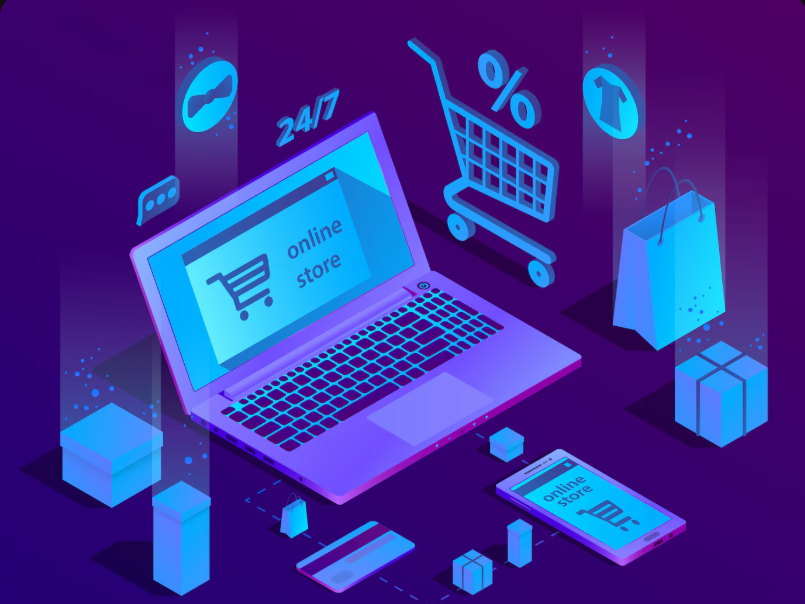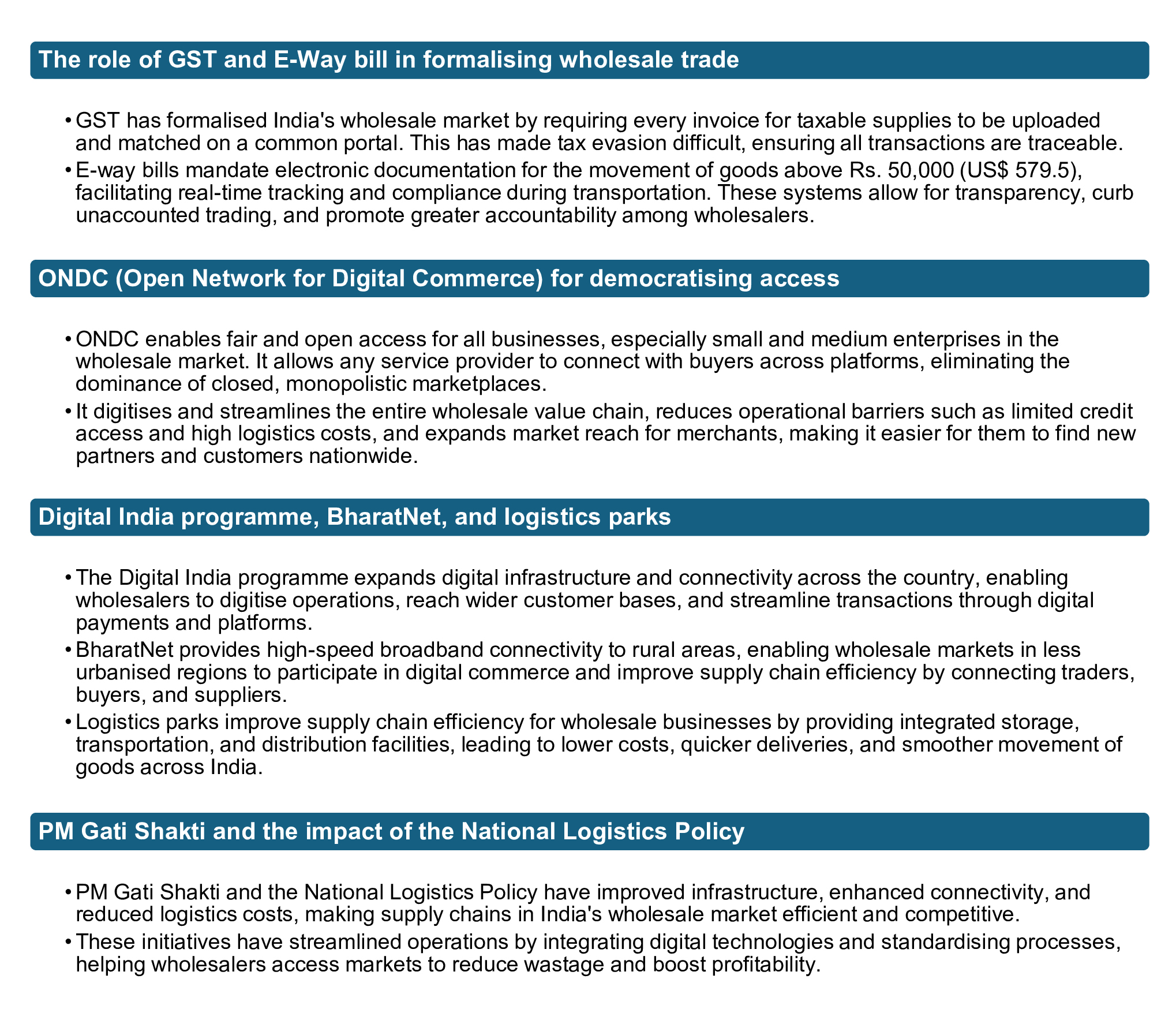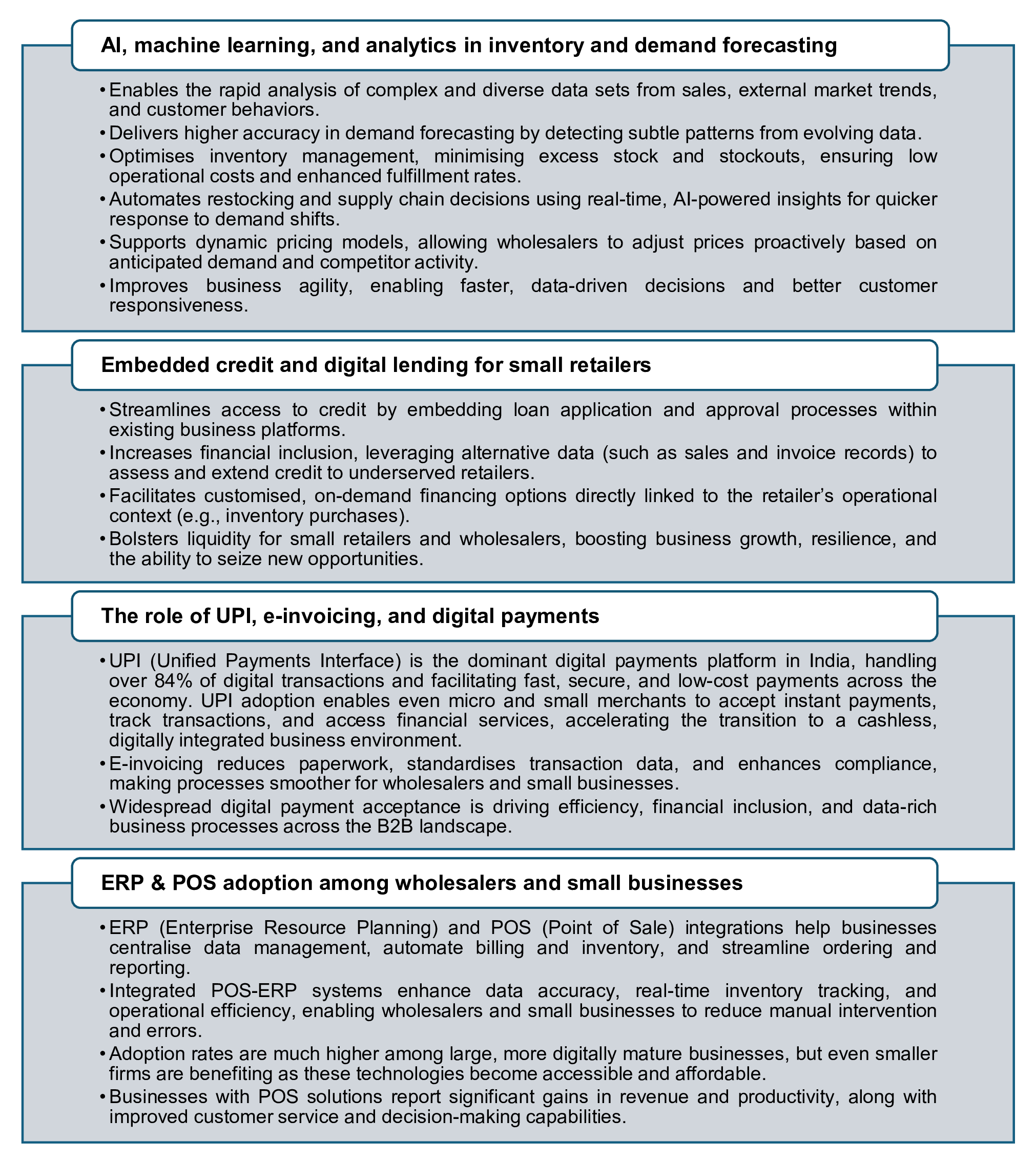SEARCH
RECENT POSTS
Categories
- Agriculture (28)
- Automobiles (18)
- Banking and Financial services (31)
- Consumer Markets (46)
- Defence (6)
- Ecommerce (20)
- Economy (66)
- Education (12)
- Engineering (6)
- Exports (21)
- Healthcare (24)
- India Inc. (8)
- Infrastructure (29)
- Manufacturing (26)
- Media and Entertainment (13)
- Micro, Small & Medium Enterprises (MSMEs) (15)
- Miscellaneous (30)
- Perspectives from India (33)
- Pharmaceuticals (4)
- Railways (4)
- Real Estate (16)
- Renewable Energy (17)
- Research and Development (8)
- Retail (1)
- Services (6)
- Startups (15)
- Technology (53)
- Textiles (6)
- Tourism (12)
- Trade (5)
From Bazaar to Broadband: The Changing Face of India’s Wholesale Market

Wholesale Indian markets have deep historical roots, often as old as the cities themselves. Initially, wholesale markets were set up to serve the needs of people and were typically found in the inner-city areas which were easily accessed by all. However, the rapid integration of technology such as modern retail, efficient supply chains, app-based ordering, and e-deliveries, has changed how consumers meet their basic needs, reflecting evolving lifestyle demands and transforming the entire industry. These technologies have led to the emergence of online wholesale markets and digital kirana wholesale platforms in India. Nevertheless, traditional wholesale markets are still relevant to cities especially for commodities like sea food, agriculture, and fresh products.
India’s wholesale market has shifted from bazaar to broadband in last few years. The increasing adoption of the internet due to improved connectivity, penetration of digital serving platforms due to advanced technology and rising urbanisation are major factors driving this shift. According to 6Wresearch, India’s retail and wholesale market is expected to grow at a CAGR of 10% in 2025-31, while the wholesale segment alone is projected to grow at a CAGR of 6.5% during the same period.
The rise of B2B E-commerce in Indian wholesale
E-commerce, the online sale of tangible commodities, has significantly expanded corporate reach and sales potential, encompassing various businesses with both physical and digital outlets. India’s Business-to-Business (B2B) e-commerce market is a growing segment serving a variety of buyer and seller groups, including manufacturers, distributors, wholesalers, retailers, service providers, and exporters. A broad number of product categories are also covered, including consumer, industrial, healthcare, and digital services goods as well as agricultural and aliied products. According to Bessemer Venture Partners, India’s B2B e-commerce market is projected to reach a market size of Rs. 17.3 lakh crore (US$ 200 billion) by 2030, led by prominent players like Udaan, JioMart, and others. India’s B2B general traders are gradually shifting towards organised digital trade with intend to access underserved markets in small towns and tier-II cities. E-commerce penetration has made way for small and medium enterprises due to better accessibility and efficient supply chains. According to Brickwork Ratings, ~100% of Indian pin codes have adopted e-commerce, with over 60% of transactions from tier-II cities and smaller towns, which contribute to half of all shoppers and three of five orders. The average selling price in these areas is slightly lower than in tier-I cities. Electronics and apparel make up ~70% of the market, while emerging categories include ed-tech and hyperlocal service. Online shoppers from tier-II and tier-III cities have played a major role, with their share rising from 46% in 2020 to 56% in 2024 and is expected to reach ~64% by 2030.
Government reforms and infrastructure driving wholesale modernisation
India’s wholesale sector is undergoing significant transformation, driven by several key factors, with government reforms playing a major role in supporting this shift. These reforms include policies and improvements in infrastructure. The goal is to improve efficiency, transparency, and inclusivity making the Indian wholesale market better regulated, more integrated into the formal economy, and effectively monitored by tax authorities.

New-age wholesale: Tech, credit and data integration
Digital marketing plays a crucial role in B2B wholesale, allowing wholesalers to connect business buyers directly and reduce their dependence on intermediaries. SEO, email marketing, LinkedIn outreaches, and focused paid promotions are used to draw in business clients over the internet, build brand authority and generate high-quality leads. Through such internet-based strategies, wholesalers can set up strong client relationships, increase market reach, and drive direct sales.

The way forward
India's wholesale market is shifting from its traditional roots to a modern, digitally connected system. This change is fuelled by more people using the internet, the rise of B2B e-commerce, and government efforts to boost efficiency and transparency. The surge in online shopping, especially in small cities (Tier II and Tier III), shows the huge potential of e-commerce to support small and medium businesses. This is not just a technology upgrade; it aims to create a fair economy where more businesses can succeed. With e-commerce reaching every part of India and most transactions occurring in small towns, the economic fairness is evident. As the industry adopts digital marketing, credit options, and data analysis, India's wholesale sector is not only changing; it is also building a transparent, strong, and globally competitive future for everyone involved.
FAQs
What are the primary drivers behind the shift in India's wholesale market from traditional bazaars to broadband?
Increased internet adoption, penetration of digital platforms, and rising urbanisation are key factors.
How are government reforms contributing to the modernisation of India's wholesale sector?
Government reforms are improving efficiency, transparency, and inclusivity, leading to a regulated and integrated market.
What digital marketing techniques are crucial for Indian B2B wholesalers?
Search Engine Optimisation (SEO), email marketing, LinkedIn outreach, and focused paid promotion are used to connect with business buyers.
What is the impact of a digitally connected wholesale system on economic fairness and opportunity in India?
It fosters a fair economy by providing businesses with opportunities, especially in small towns.
What is the core aim of modernising India's wholesale sector?
It aims to create a transparent, strong, and globally competitive future for all involved businesses.
What types of players are leading the growth of India's B2B e-commerce market?
Prominent players like Udaan, IndiaMART, Amazon Business, Flipkart Wholesale, and JioMart are some of the leaders in this sector.
















